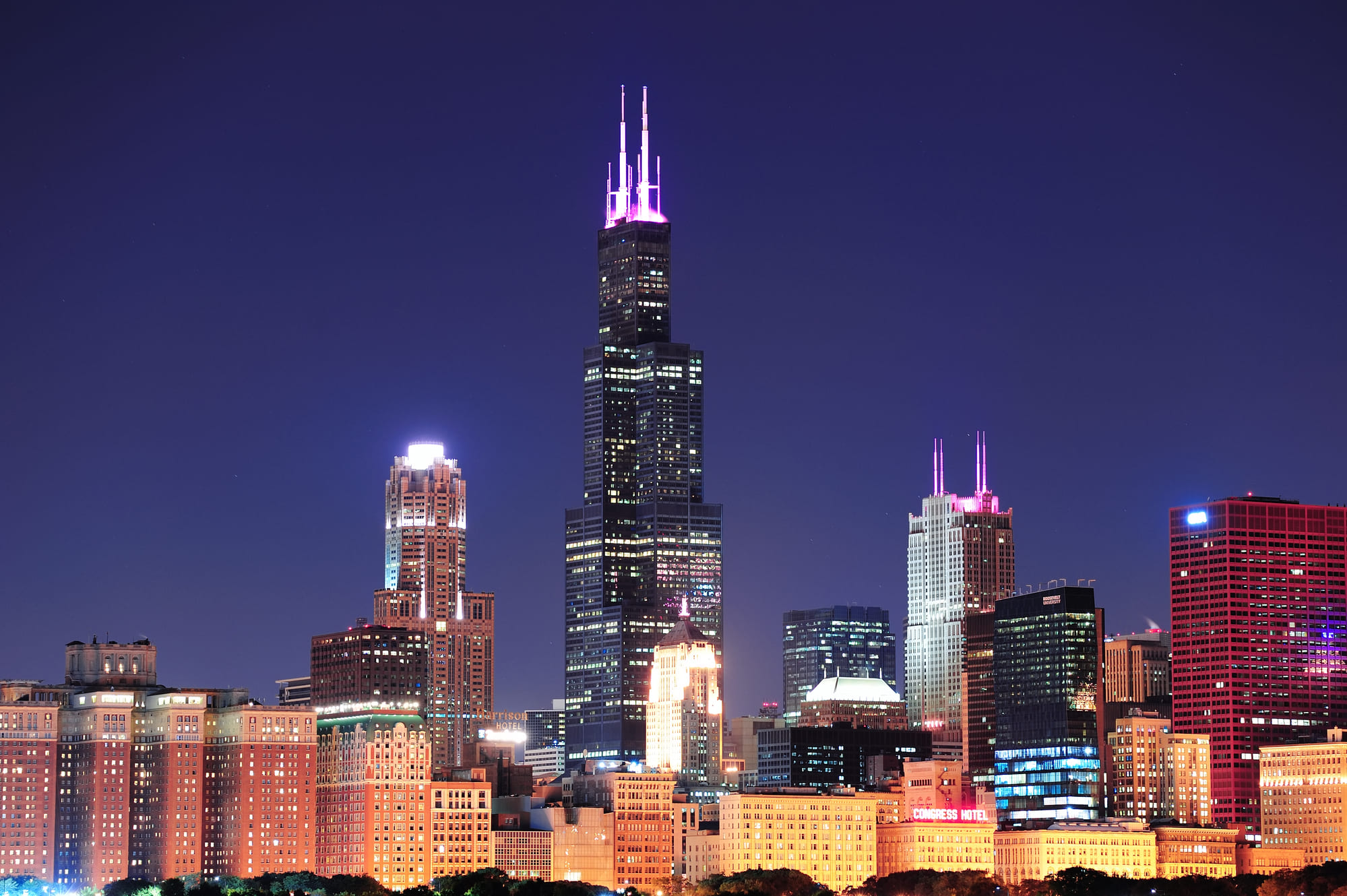History of steel skyscrapers
The term skyscraper as we know it now appeared for the first time in an American architectural magazine in the summer of 1883. Until the time when the development of multi-storey buildings started in Chicago, the word skyscraper referred to a kind of sail, style of hat, long-legged horse or very tall person.
The high-rise buildings known today as skyscrapers appeared owing to the discovery of the Bessemer steel production process, a metallurgical breakthrough from the late 19th century.
Before the advent of this new steel production method, steel was mainly used to make household items, such as tools or kitchen utensils. A discussion with the Emperor Napoleon III was a turning point for Sir Henry Bessemer. The emperor needed a lot of steel at a low cost for rifles and cannons. This serves as another example when the interests of the military industrial complex were a driver of scientific and technological progress. In 1856, Bessemer patented the first inexpensive method of industrial steel production using iron. Bessemer’s expertise made it possible to reduce the cost of steel from 40 to 6-7 pounds sterling per tonne, thus improving production time and increasing production volumes.
Fortunately, inexpensive steel was applied not only in the manufacture of artillery pieces but also in peaceful multi-storey buildings. Before Bessemer, architects made attempts to increase the height of buildings by thickening brick walls on the lower floors, but without luck. The mass production of inexpensive steel made it possible for urban planners to bring to life the idea of skyscrapers built using steel frameworks.

In 1864, this method was tested in Liverpool during the construction of an office building called the Oriel Chambers. Its distinguishing feature was a steel framework that supported a glass wall. Today, the Oriel Chambers is considered one of the most outstanding architectural masterpieces of its time. In the late 19th century, though, the building’s design met with mixed responses. For example, the UK’s oldest business magazine, The Builder (renamed Building in 1966), called it “ludicrous”.
Liverpool’s steel building was just five storeys, though. For this reason, the Home Insurance Building is considered the world’s first skyscraper. It was designed by architect William Le Baron Jenney and built in 1885 in Chicago. The 10-storey building stood 42 metres in height and served as the headquarters of a home insurance company. It was supported by a revolutionary steel frame consisting of vertical columns and horizontal beams, which allowed for much greater stability.
The light masonry walls were put on the steel framework as curtains (there was no longer a need to increase the wall thickness to make a high-rise building more stable). Thanks to its steel frame, the 10-storey building did not pose a risk of toppling under its own weight. The rooms were also brighter in buildings with such framework, as the steel made it possible to significantly increase the number of windows.
Building the first of a new generation of steel-framed skyscrapers set the standard for various other innovations in construction, including elevators, roof structure and plumbing. The Home Insurance Building stood until 1931. Later, another skyscraper was constructed in its place: the 45-storey LaSalle National Bank Building.
Built in 1902, the Flatiron Building is an architectural landmark of the borough of Manhattan in New York City. For more than 100 years, it has stood as a symbol of the Big Apple. This unusual office building consisting of 22 storeys was built in an extremely short time of just one year. The skyscraper’s steel frame was made by American Bridge Company, which specialised in bridge construction. The steel structures were partly pre-assembled and delivered to the construction site. This allowed the construction of the Flatiron Building to proceed at an amazing speed for its time, at a pace of no more than a week per floor.
Initially, the building’s unusual triangular shape evoked mixed responses from the public. There were concerns that such a strange building, which was situated in a rather windy area, would quickly fall over. Local bookies were even taking bets on how far the building’s debris could be found after its collapse. However, the architects calculated that the steel framework enabled the building to withstand four times the amount of wind force than it could ever be expected to endure.
Aside from its triangular shape, this office building had other specifics. For example, it lacked an air conditioning system, had a single staircase and the oddly shaped rooms formed a draughty labyrinth. Nevertheless, the value of the Flatiron Building was estimated at US$190 million in the 2010s.

Eye-catching contemporary skyscrapers
Another well-known steel skyscraper, the Empire State Building (1931), is also situated in Manhattan. Over time, this building has become an iconic symbol of New York City, as well as an important part of American culture and life. The famous 102-storey giant stands 443 metres tall and has appeared in nearly 250 films and television shows, including Doctor Who, Sleepless in Seattle, Independence Day and King Kong.
The Empire State Building stood as the world’s tallest building for almost 40 years, until the World Trade Center was constructed. After the twin towers were destroyed in a terrorist attack, the Empire State Building regained its status as the tallest building in New York City, which it held until 2012. However, it lost its world-leading position forever.
Structural steel for this iconic skyscraper was prefabricated in anticipation of a revision to New York City’s building code that governed the safety of new high-rise buildings. The preliminary work made it possible to install the initial steel framework of the Empire State Building a few days after mayor of New York City signed the appropriate documentation. During the first 10 days of construction, the building rose to 14 storeys. The production of more than 50,000 tonnes of steel for this project was one of the largest orders for steelmakers of its time. The process of the skyscraper’s construction was admired by contemporaries. Numerous photos were taken at each construction stage, and dozens of articles and essays were published. As the New York Times wrote, “Like little spiders they toiled, spinning a fabric of steel against the sky”.
The assembly of the Empire State Building’s steel structure, which featured the Art Deco design that was popular at the time, was completed six months after construction began. The building’s cornerstone contained a box with the previous day’s edition of the New York Times, a full set of US banknotes and coins minted that year, as well as photographs of the construction workers, whom the public greeted as heroes.

Today, the 108-storey Willis Tower skyscraper in Chicago is considered the world’s tallest building made of steel structures (concrete or composites have been used for the construction of taller buildings). The Willis Tower is 527 metres tall, including its spire. The Willis Tower’s architect, Bruce Graham, is said to have been inspired by a pack of cigarettes. The skyscraper’s structure consists of nine welded steel square tubes placed in a three-by-three grid arrangement. Each tube has a footprint of 23 metres by 23 metres. Such an unusual solution was used in the construction of the Willis Tower for the first time. The peculiarity of the innovative design is that the skyscraper’s height can be significantly increased if necessary.

The Minsheng Bank Building in Wuhan, China, is the tallest skyscraper in mainland China that is made entirely of steel and lacks a reinforced concrete core. The steel structure of the Minsheng Bank Building weighs 24,000 tonnes. The height of the 68-storey skyscraper is 325 metres. This building was officially put into service in 2010. According to Chinese law, a secure refuge floor must be provided every 100 vertical metres when constructing skyscrapers. Such space shall be complete with a firefighting system, independent ventilation system, illumination, etc, and be used for people during evacuation in case of fire. The Minsheng Bank Building has four such evacuation floors. In addition, each floor is supported by steel cylinders filled with concrete to improve the fire resistance of the steel structure. External steel surfaces are also coated with fire-retardant paint. The builder guarantees that the steel structure will not melt after even three hours of intense fire.

Another steel giant is the unusual Cheung Kong Centre skyscraper in Hong Kong. A total of 23,400 tonnes of steel were used for its construction. The Cheung Kong Centre is a 68-storey office building with a height of 283 metres. It opened its doors to tenants and visitors in 1999. The external walls of each floor are made entirely of glass with no visible additional columns, which opens a panoramic view of the city from anywhere inside a room. The window glass surfaces contain optical fibres that can illuminate the building at night. The unusual illumination is perhaps the building’s only exterior highlight. Aside from that, the Cheung Kong Centre looks rather minimalistic. The office centre’s design took into account feng shui principles: the architectural solution aims to offset the negative energy produced by the neighbouring skyscrapers.
Structures with steel flooring, vertical and lateral steel structural members are built relatively rarely nowadays. Most skyscrapers are now constructed using various composites, reinforced concrete or combined steel and concrete solutions. Nevertheless, the exceptional robustness of the steel-framed structure created a special recognisable architectural style, the examples of which will continue to delight to the eye of grateful connoisseurs of art.
